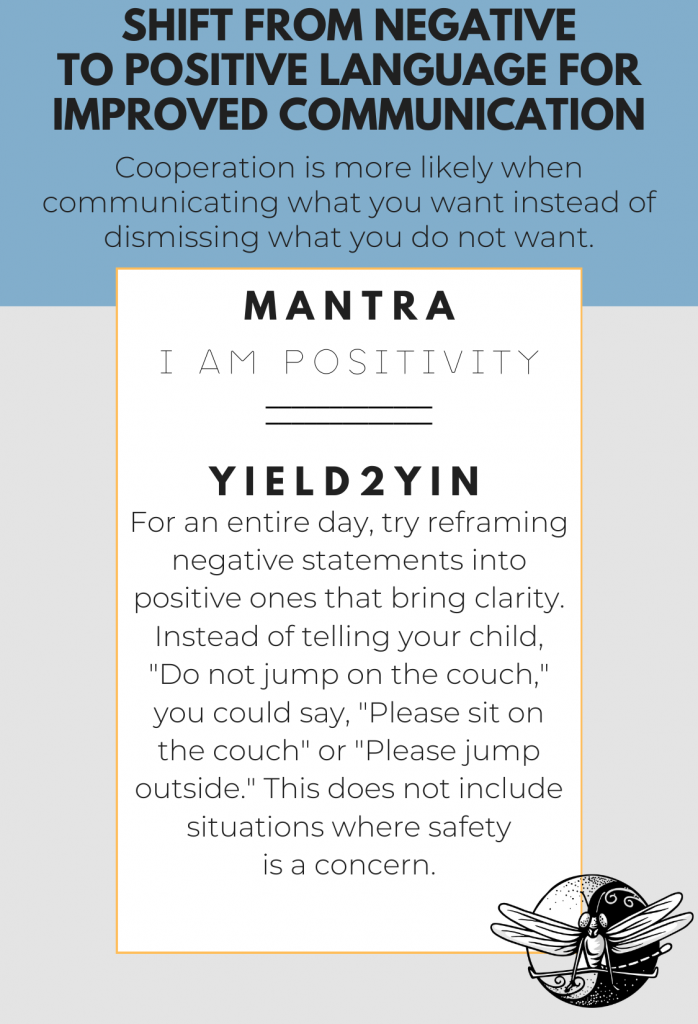Over the next weeks, we will be diving into positive parenting skills that not only help teach and guide your children, but that do so in a way that preserves and strengthens your parent-child bond. Both parent and child are viewed as holistic beings – with valued and respected minds, bodies, and spirits.
All of these gentle skills can be adapted for different parenting stages. A 17-month-old and a 17-year-old can both benefit from a parenting approach that includes, for instance, positive language and limit setting.
For each positive parenting skill, you will learn the meaning and goals. I will also make sure to add an example or two, so it is clear how these skills can be applied in regular day-to-day life.
1. Positive Language

For sale on Amazon soon!
Positive Language Definition
Omit negative language when raising your children. Avoid the words “no, don’t, stop, quit, not.” This does not only refer to negative criticism, but also to simple commands. As much as possible, use positive language instead, including when discipling your children. The one exception is when safety is a concern.
Positive Language Examples
- “Don’t run in the house!” becomes “You can run outside, or you can walk in the house.”
- “Stop throwing your food!” becomes “Keep your food on your plate, please!”
- “You are not spending all weekend in bed!” becomes “I’d love for you to rest up this weekend as well as join us outside for family time!”
Positive Language Goal
Positive language changes our brain. Not just our children’s brains, but ours too. However, there is a lot more plasticity in our children’s brains than in ours. When children are young, from birth on, neural pathways are being built at lightning speed.
Imagine how different those neural pathways in the brain look if they developed based on positive and loving language that builds connection compared to negative, or worse, critical language, which feels like rejection, and leads to disengagement, insecurity and loneliness?
To have a deeper understanding of the childhood brain and the importance of the input from the outside world on their stress response and neurochemicals, I recommend watching the above video on YouTube. Here are some of its key points:
To have a deeper understanding of the childhood brain and the importance of the input from the outside world on their stress response and neurochemicals, I recommend watching the above video on YouTube. Here are some of its key points:
- The brain is organized from the bottom to the top of the brain and processes information sequentially
- The brain is malleable for people of all ages, but the younger we are, the higher the capacity for the brain to change
- The higher parts of the brain are easier to change than the lower parts of the brain:
- higher parts of the brain (easier to change): “more complex, abstract thinking”–executive functioning, concrete cognition, etc.
- lower parts of the brain (harder to change): “simpler, more primitive”–emotions, attachment, motor skills, appetite, sleep, heart rate, temperature, etc. (listed from hard to harder)
- The brain is “use dependent” and looks for “pattern repetition” – since the brain is so responsive to experiences, it makes sense that having more positive interactions is all important for healthy brain development. When it comes to the use of positive language, just remember that “use dependent” and “pattern repetition” basically means: the more the better!
- If brain function is compromised because of childhood trauma (physical, mental, and/or sexual trauma), there will be “compromised cortical modulation” and therefore increased probability that there will be challenges with self-regulation, incl.
- frustration tolerance
- impulse control
- channeling urges, incl. aggressive urges
Here is a short video clip (5:34 min.) by a young kid who explains the effects of language on the human body in simple, yet clear terms. If words have such a strong effect on water crystals, then imagine the effect words have on our bodies considering between 50% to 75% of the human body is made of water.
2. Selective Attention
Selective Attention Definition
When you give your child selective attention, you pay attention to one behavior, the positive one. You ignore another behavior, the negative or problem behavior.
Selective Attention Example
While cleaning up, Ella starts crying and says that she is tired of always having to clean up the toys and of her brother never having to help out even though he played with the toys too (he is still doing his homework, by the way). You reply to Ella, “I know this is hard because your brother played with the toys too, and I know you have had a long day and feel tired…” (Note: this is a reflection – here comes the selective attention part) “…Thank you for cleaning up the toys. This is really helpful not just to me, but to everyone in the family.”
Selective Attention Goal
Selective attention helps your children focus on the positives. It makes them more aware that multiple thoughts, feelings, and behaviors can be going on at the same time, both positive and negative. Yet in life, we can choose to focus more on the positive and ignore the negative (as long as it’s not a safety issue).
3. Transitions
Transitions Definition
Transitional statements help your child move from one activity to the next. We transition all the time; usually, we do so automatically without awareness. “Transitions” as a parenting technique refer to mindful transitions.
Transitions Example
#1: Your toddler is having a wonderful time taking a bath. To help them transition, you say: “Buddy, you have 5 more minutes in the tub, and then mommy is going to help dry you off, put your PJs on, and brush your teeth, so we can then read books together.” Three minutes later you say: “Buddy, you now have 2 more minutes left in the tub, and then mommy is going to help dry you off, put your PJs on, and brush your teeth, so you can go and choose 3 different books.” The repetition is intentional. We want our children to remember what comes next. Knowing what to expect gives them a sense of safety and security, regardless of whether they like all of the upcoming activities or only some of them (and sometimes none) – it still provides some certainties in their lives. When it’s time for bath time to end, let your toddler know time is up. You can also add two choices: “Buddy, bath time is over; you have two choices: Do you want to push the drain stopper, or do you want mommy to do it?”
#2: You are driving your sixth grader to school in the morning and remind them of what their day will look like. “Remember today is Wednesday, which means you only have half a day of school. When I pick you up at 12:30, we will grab some lunch, and then I will take you to your violin lesson. When you are done with music class, we will head home, so you can take a little break before starting your homework. I know you still have that science project to work on. When your work is done, you can go grocery shopping with me or stay home, whichever you prefer. As soon as I come home from the store, I need you to help me make dinner. What should we have tonight?” When you pick up your child from school at 12:30, remind them of their schedule again. It is also fine to ask them, “Do you remember your afternoon schedule?” and have them tell you instead of you telling them.
Transitions Goal
Transitions teach children about scheduling and time management. They also give children a sense of control over their daily lives.
Can you imagine your partner walking in while you are taking a relaxing bath, and saying without warning, “It is time to go to the hardware store” (while pushing the drain plug!)? Look at it from a child’s perspective: if their parent does not explain to them what their day is going to look like and give them little reminders throughout the day, then they have no way of knowing what comes next. They have to tolerate continuous, yet unnecessary, uncertainties. This lack of a sense of control can cause a child to feel worried, anxious, frustrated, irritable, and in general, more tense.
(Related Reading: The Benefits of Using Rebounds in Everyday Life)
4. Redirect
Redirect Definition
A redirect is a distraction. You see your child engaging in (or about to engage in) an activity that is inappropriate or unsafe. Or you hear your child talking negatively – maybe they have been ruminating? Or are stuck in a negative feedback loop? – about something or someone for too long. So, after validating their experience, you help them refocus on a pleasure activity or a more positive thought.
Redirect Example
You have listened to your child complain about their teacher for the last 15 minutes: the unfair tests, the ungodly amount of homework, the teacher’s pets … wait, we are not done yet … their poor taste in clothing, their annoying voice, their stupid stories about their weekends. So yes, you validate, validate, validate your child, and then, eventually, you help your child with thought-stopping and changing the topic. You could ask, “Tell me something good that happened at school today!” Or you could talk about a different topic altogether and suggest a calming technique, “Would you like a snack? I will gladly make you some of your favorite avocado toast and pour you a glass of sparkling lemon water.”
Redirect Goal
A redirect helps prevent injuries and teaches children how to manage their behaviors by exploring different (safe and appropriate) options. This is how they start collecting different tools for their coping skills “tool belt”, to be used in the future whenever they need them.
5. Limit Setting
Limit Setting Definition
Limit setting is boundary setting. I like to use Gary Landreth’s “limit setting A.C.T. Method”:
- Acknowledge the feeling
- Communicate the limit
- Target acceptable alternatives
Limit Setting Example
You see your child with a pair of scissors ready to cut into your work papers. You say, “I see you really want to cut this paper with your scissors. These papers are mommy’s work papers and not for cutting. But here is some paper for you that you can cut.”
- Acknowledge the feeling: “I see you really want to cut this paper with your scissors.”
- Communicate the limit: “These papers are mommy’s work papers and not for cutting.”
- Target acceptable alternatives: “But here is some paper for you that you can cut.”
Limit Setting Goal
Limit setting teaches your children about boundaries – how to respect others’ boundaries and how to hold their own boundaries (through the parent’s modeling). It also teaches responsibility and self-control.
If you want more information about and examples of the A.C.T. Method as well as find out what to do if your child still does not listen after you go through these 3 steps, take a look at this blog: “Setting Limits: The A.C.T. Method.”
6. Rules
Rules Definition
House rules are rules that need to be followed at all times without exception. The difference between breaking a house rule and disobeying in any other way is that breaking a house rule can lead to safety issues either with self, others, or around property, whereas not listening in general refers to minor inappropriate behaviors when safety is of no concern.
Rules Example
Charlie, a 4-year-old boy, has the following problem behaviors:
- Opens the front door without the parent being aware and just takes off
- Hits his parents and plays roughly with his siblings
- Destroys his toys
The rules are written down on a list and hung on the refrigerator with a magnet. If Charlie cannot yet read, use both words and images on the house rules list. Parents and children work on the list collaboratively. Here is an example:
Charlie’s House Rules:
- Ask for permission to leave the house
- Use gentle hands with your parents and your siblings
- Play gently with your toys
A “zero tolerance policy” for breaking house rules means that, if Charlie hits his brother, there is an immediate consequence without any kind of warning. Ideally, the consequence is a logical consequence (read more down below!).
Typically, when safety is not a concern, we give our children a warning when they do not listen the first time. This means that we give them another chance to comply before implementing a logical consequence. For example, “I have asked you several times to turn off the TV. I’m going to count to five: if you choose to turn it off within the count of five, you will still be able to watch your show tomorrow, but if not, I will have to turn off the TV myself, and you choose a no-TV day tomorrow.”
Rules Goal
House rules provide a basic sense of safety, both of people and their property, to everyone in the family, including the child with the problem behaviors.
7. Consequences
Consequences Definition
Consequences, both logical and natural consequences, teach children that with every choice they make, there is a certain outcome.
- Logical consequences are implemented by the parent and are clearly connected to the problem behavior.
- Natural consequences play out by themselves without an active involvement of the parent.
Logical Consequences Example
Your teenager’s curfew is midnight, yet they don’t come home from a party until 12:20am. They did not call you to tell you they would be late (nor picked up the phone when you called them).
They ask to go to another party the next weekend and you say no, not this time, because they broke your trust the prior weekend. Or, you tell them their curfew is now 11pm for the next month, and if they can show you that they are capable of following through with that, then you will change it back to 12 midnight the month after.
A not-so-logical consequence would be, because they missed their midnight curfew, they now have to clean all the bathrooms in the house . You can still have them help you clean, of course, but just don’t tie this chore to the problem behavior; rather tie this one to, “We are a family and therefore we all help each other with the family household chores.”
Natural Consequences Example
The weather forecast predicts heavy rain and you tell your child to bring a raincoat to school. They refuse to listen and start their 2-mile long bike ride to school. It starts pouring, and your child arrives at the school gates completely soaked. You do not bring dry clothing to school, but instead let the natural consequence play out by itself.
Your child now has the opportunity to be creative as they are figuring out what to do next. They can come up with different options all by themselves that do not include, “Call mom and ask her to bring me a dry set of clothing”. They start thinking of solutions that are outside of the box:
- I can let my clothes dry over time
- I can go to my locker and wear my gym clothes
- I can ask Taylor (their friend) if they happen to have some spare clothing
- I can go to the front office and ask if I am allowed to wear something from the lost and found bin
Consequences Goal
Consequences give children the opportunity to learn from their mistakes and to become more resilient, all within safe parameters, of course. Consequences are never meant to punish children, only to teach them. Consequences are skill-building.
Think about it this way: if you decide to spend your entire Christmas bonus several months early by putting a bunch of items on your credit card, you will not be able to spend your bonus again around the holidays. This is a natural consequence. And, you will have to pay interest on the credit you took out, which is a logical consequence. These consequences, both natural and logical, are not a punishment, but an opportunity for skill-building – it’s up to you if you take it or leave it!
Yield2Yin
- Book Recommendation: Simplicity Parenting: Using the Extraordinary Power of Less to Raise Calmer, Happier, and More Secure Kids by Kim Johne Payne
- Mantra: I AM SKILLFULNESS // with diaphragmatic breathing
- Yin Yoga Asana: Snail Pose







